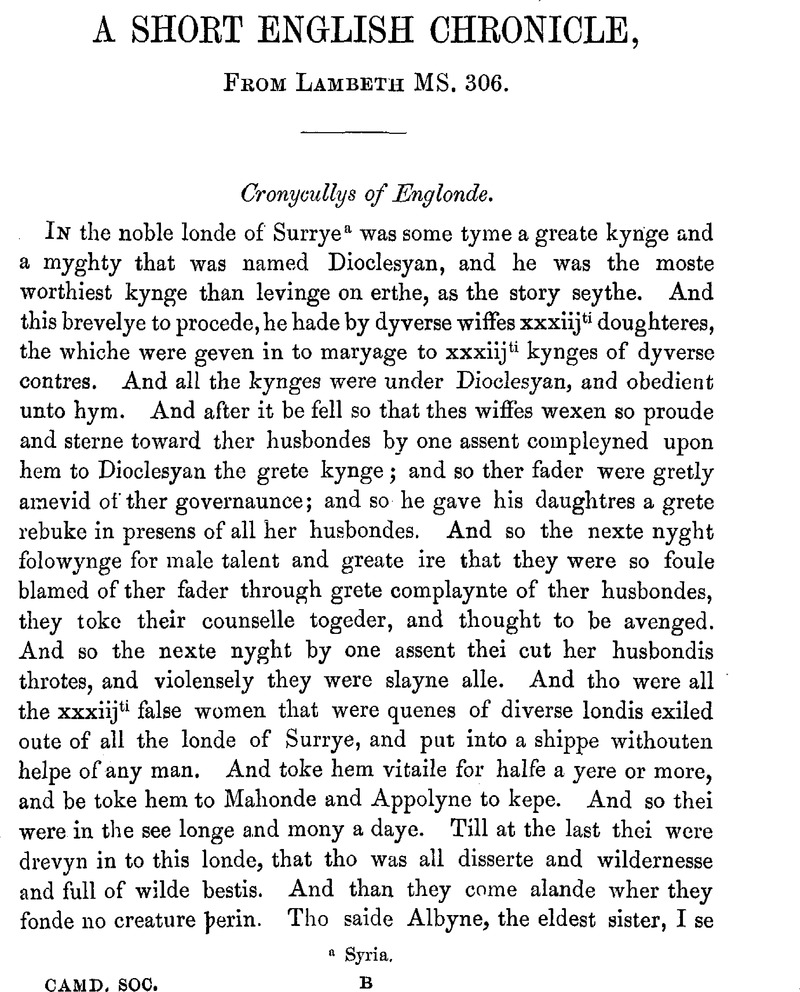No CrossRef data available.
Article contents
A Short English Chronicle, From Lambeth MS. 306
Published online by Cambridge University Press: 24 December 2009
Abstract

- Type
- A Short English Chronicle
- Information
- Copyright
- Copyright © Royal Historical Society 1881
References
page 1 note a Syria.
page 2 note a the grete cyte of. These words are interlined by a second hand, by which most of the side-notes have been supplied.
page 2 note b Erased in the MS.
page 3 note a In the names Eborank and Eborawyke, the “o” is inserted between b and r by the second hand, both in the text and in the margin.
page 4 note a The “o” in this name is altered by another hand into “a.”
page 7 note a Lucium. So in MS. This marginal note is mutilated, the edge of the paper having been cut by the binder, so that it is uncertain what the date assigned to the conversion of Lucius was. But it was most probably 163 (CLXIII), the L being now lost.
page 8 note a Over the name “Constantyne” in the text is written by the annotator “Emperowre.”
page 8 note b Armorica.
page 10 note a The names of the eight kingdoms are repeated in a marginal note.
page 12 note a The “ge” in this name, in both these places, alike in the text and in the margin, is an interlineation by another hand.
page 15 note a This sentence is added in by the hand of the marginal annotator.
page 16 note a Sic in MS.
page 17 note a In the margin occurs the following note by another hand: “Robert Curthos primogenitus cui Willelmus Conquestor in sua morte reliquit sibi totam Normaniam, ut habetur in alia cronica.”
page 17 note b Malcolm.
page 19 note a Gualo.
page 19 note b So in MS., repeated.
page 24 note a The annotator here commits the gross blunder of representing Richard II. as the son, instead of grandson, of Edward III.; and, not content with this inaccuracy in the margin, he has written over “Prince Edwardis sonne” in the text the words “Edwardus iijus” above the line.
page 25 note a After “Seint Vincentes daye” about a line and a-half is crossed out, beginning “of May was the Erthe quake.” The erased words occur in the text immediately below; which shows that the MS. is here a copy and that the transcriber had missed a line.
page 27 note a The original text read “Sir John Busshe;” but “John” is crossed through and “Wylliam Scrowpe” inserted in the margin by another hand, with a caret in the text after the cancelled word.
page 28 note a There is no stop here in the MS. the punctuation of which is evidently wrong. The sentence ends with “Kynge Richard,” the words “the ijds” being added by the corrector's hand. A mark is also put to indicate the beginning of a new sentence at “Henry of Bolyngbrok.”
page 28 note b What follows is a corrupt text of Lydgate's Verses en the Kings of England which I printed from another MS. in “Collections of a London Citizen” edited for the Camden Society in 1876. They are here printed precisely as they stand in this M
page 29 note a So in MS., instead of Rone, i. e. Rouen.
page 30 note a Corrected into “lj,” the.“i” being erased with the knife.
page 33 note a So in MS.
page 34 note a Owing to an erroneous entry before the last paragraph which is crossed out, this and all the subsequent years of the reign have been dated a year in advance and afterwards corrected, as far as the 39th year, originally written “xl”, in which the numeral letters are simply crossed out without further correction,
page 35 note a So in MS. The word “the” before “Provynce” is interlined in a later hand.
page 36 note a Crossed out.
page 37 note a Corrected from “xlvij.”
page 41 note a This between brackets has been added by the Corrector at the top of the page, * fo. 24b.
page 42 note a The original reading was “Oxenford,” which has been corrected into “Exceter” by a later hand.
page 45 note a The following note occurs in the margin opposite the 28th year: “This yere were the fyrst g[ro]tes and di. grotes, that is to s[aye] iiij d. and ij d. of sylrer made, [and] afore ther was no monye b[ut] the noble, the half noble, the [far]thyng of gold and sterlyng o[f] sylyer.”
page 46 note a So in MS. Doubtless the words “stella comata” written above under the regnal year ought to hare been inserted here.
page 47 note a The words between brackets are inserted by the Corrector.
page 47 note b The names and heading for this year are supplied by the Corrector at the foot of a page.
page 49 note a I confess the meaning of these lines is beyond me.—Editor.
page 49 note b “lxxxxx.” So in MS.
page 51 note a The words following “Seint Edwarde” are added by the Corrector.
page 52 note a The words “the Secunde” and “from Pomfret—decessyd” are inserted by the Corrector in the margin.”
page 52 note b “there—freers.” These words are inserted by the Corrector.
page 52 note c Cirencester.
page 52 note d This sentence is inserted by the Corrector in the margin.
page 52 note e “on Mary Mawdelen day.” These words are inserted by the Corrector.
page 53 note a “and beheded.” Added by the Corrector.
page 53 note b This sentence beginning “The same yere” is added by the Corrector.
page 54 note a This sentence is added in the margin by the Corrector.
page 54 note b The words following “Westmestre” in this sentence are added by the Corrector and carried out into the margin.
page 54 note c “the ijde” is interlined by the Corrector.
page 54 note d The name was “John” in the text, but it is crossed through and “Wylliam” is written over. The Corrector has added the following note in the margin, relative to the year of his mayoralty: “Primo, quia bis fuit maior civitatis.”
page 57 note a Meaux en Brie.
page 57 note b The last sentence is added by the Corrector in the margin.
page 58 note a This parenthesis is inserted by the Corrector.
page 58 note b This sentence is inserted by the Corrector in the upper margin of the MS.page 60 note a This sentence is added by the Corrector.
page 60 note b Corrected from “Lauernce.” The Corrector ought also to have noticed that “Dessembre” should have been November.
page 60 note c The parenthesis added by the Corrector.
page 61 note a This sentence is added in the margin by the Corrector, who has also interlined under the names of the mayors and sheriffs, “The kyng was crowned in Parise.”
page 62 note a Above these words is written by the Corrector: “uxor Henrici quinti.”
page 63 note a This sentence is inserted by the Corrector.
page 63 note b To this note is added in a hand considerably later: “and the wytche of Eye.”
page 64 note a Adam Moleyns, afterwards Bishop of Chichester.
page 65 note a The parenthesis is inserted by the Corrector in the margin below.
page 66 note a So in MS.
page 66 note b “whose—Iresheman.” This clause is inserted by the Corrector.
page 68 note a This parenthesis is added in the margin by the Corrector.
page 68 note b Cardinal Kemp.
page 68 note c This passage has been altered by the Corrector. The sentence originally stood: “And so the xiij day of Jnle John Cade was take in Kentt.”
page 69 note a William Ayscough, who was murdered in the preceding year.
page 70 note a Inserted in margin by the Corrector.
page 70 note b “the fyrst.” Interlined by the Corrector in place of “a,” struck out.
page 70 note c Pierre de Brézé, Seigneur de la Varenne.
page 70 note d Robert de Floquet, bailiff of Evreux. See Monstrelet, , iii. 71.Google Scholar
page 74 note a Francesco Coppini, bishop of Teramo.
page 74 note b Should be the 10th, which was Thursday.
page 74 note a Wentworth.


